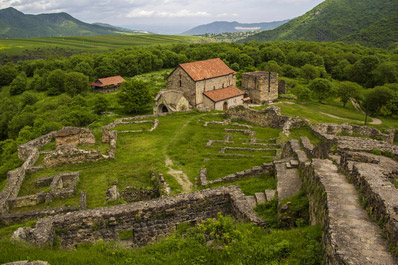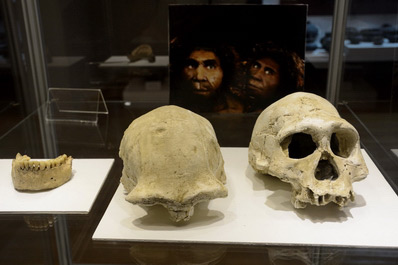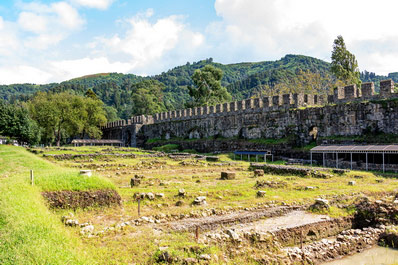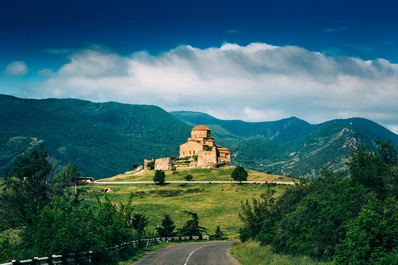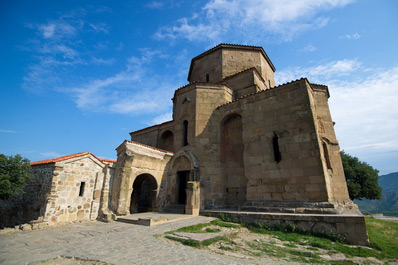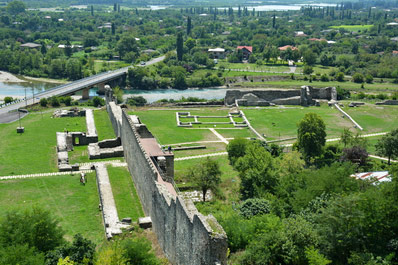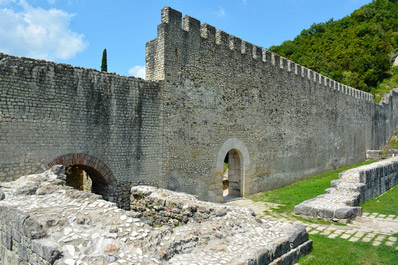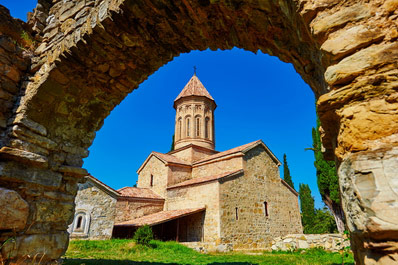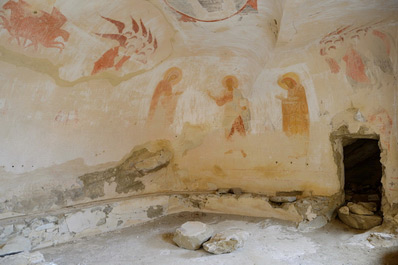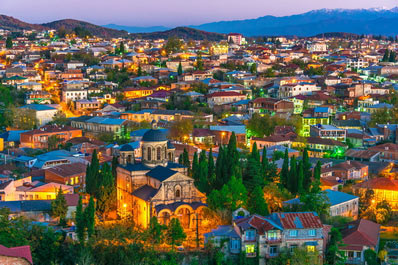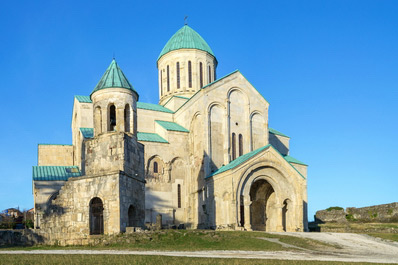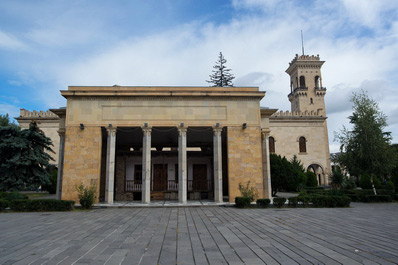History of Georgia
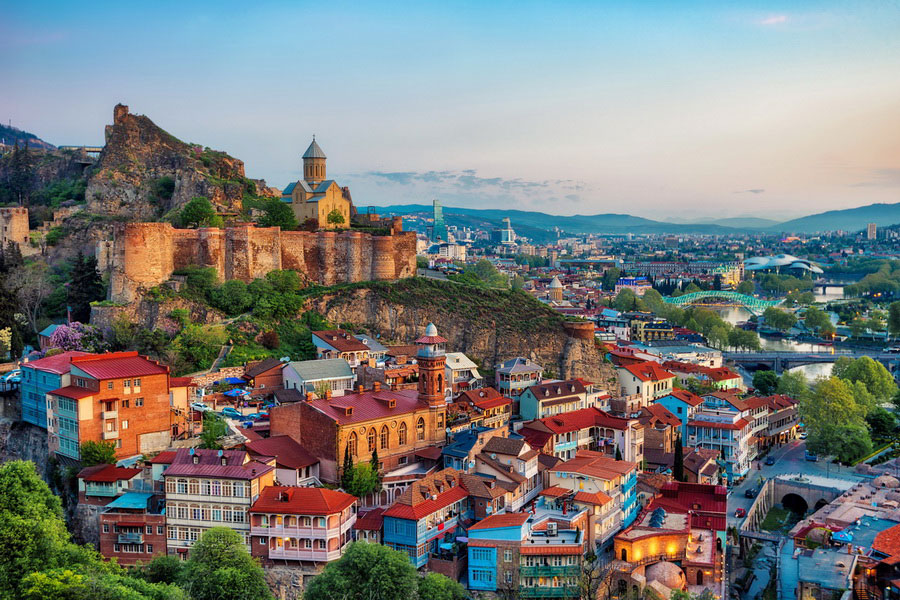
History of Georgia - From ancient to modern times
Georgia is a land with a fascinating history and culture. Unlike other countries, its cultural identity is conditioned by its special geographical location. On the one hand the country is at the crossroads of Europe and Asia, and on the other hand it is located in the middle between the Black Sea and the Caspian Sea, where it has always played a very important role.
Why Sakartvelo?
In their native language, Georgians have always called their country "Sakartvelo" and still do. The root "Kartvel" refers to the self-name of the nation of Georgians, and the prefixes and suffixes give a construction that implies "The area where the Kartvels live."
As for the Latin term Georgia, it is a Western exonym for Sacartvelo, first mentioned on Pietro Vesconte's map of 1320. All loan words are derived from "gorgan", formed from Persian "wurgan", which in turn originated from Old Persian "vrkan" - "land of wolves".
The exonym "Georgia" has the same origin, but there was a different transformation: Gorgan, Gurjan, Gurj, Gurz, Gruz. And then the Russian ending was added, characteristic also in the names of such countries as Yugoslavia, Bulgaria, Croatia and so on.
Prehistoric Georgia
One of the fascinating places of Georgia's prehistoric past is the Sataplia National Nature Reserve, located near Kutaisi. It was there that the Georgian scientist-naturalist Petre Chabukiani discovered dinosaur footprints dating back to 65 million years ago in 1925. In the reserve there are traces of 25 species of dinosaurs, and this is a unique place, because in one location are concentrated traces of both herbivores and predators.
And this is not the only place of prehistoric Georgia - in 2017, paleontologist Vaso Gabunia accidentally stumbled upon dinosaur tracks in Martvili, on the border of the villages of Balda and Gachedili.
The fact of human habitation on the territory of modern Georgia is confirmed by archaeological excavations in Dmanisi. Fragments of a human skeleton were found there, the oldest in the whole Eurasia, the age of which is 1.8 million years. You can see the bones of the first European man, as well as familiarize yourself with the medieval settlement in the Dmanisi Museum-Reserve.
For a detailed introduction to prehistoric Georgia, it is worth visiting the Georgian National Museum on Rustaveli Avenue in Tbilisi.
Origin of Georgians
There is no consensus on the ethnogenesis of Georgians. Some scientists attribute Georgians to Indo-Europeans, and others to more ancient peoples, such as Sumerians, Hittites, Subars, etc.
Historical sources mention many names of eastern and western Georgian tribes (Iberoivers, Gugars, Shavsh-Klarjeti, Tao, Macrons, Khaldokhalibs, Margvels, etc.). All of them participated in the formation of the Georgian ethnos. It is accepted that in the process of centuries-long ethnogenesis and in ancient times, there was a migration of some Kartvelian tribes to the south - to the north-western regions of Asia Minor and to the south-east along the shores of the Black Sea.
Genetic studies have shown that the Y-DNA haplogroup G-M201 prevails in the ethnic peoples of the Caucasus and is found in small frequencies in Europe, South Asia, Central Asia and North Africa. In Georgia, 39% of the population are carriers of this gene. According to the latest research in 2012, geographically this haplogroup originated somewhere near eastern Anatolia, Armenia or western Iran. Previous studies attributed its formation to the Middle East, Mesopotamia. And 32.5% of the Georgian population are carriers of the Y-DNA J-M172. This group is believed to have originated between the Caucasus, Asia Minor, and/or Western Iran.
First Georgian Unions
The first Georgian political unions were the Diaokhi and Kolha. It can be said that the history of Georgia begins with them. Diaokhi emerged in the 12th century B.C. It lay along the southeastern coast of the Black Sea and is mentioned in ancient Assyrian and Greek sources. It is known that it was a rather rich state, where metalworking and cattle breeding were actively developed.
For several centuries Diaohi opposed first the Assyrian Empire, then Urartu, until it finally fell in the VIII century B.C. The eastern part of Diaohi was occupied by the Kolkhi, who became Urartu's neighbors.
Already in the VI century BC the kingdom of Colchis was formed, which united almost the entire western part of today's Georgia - Imereti, Guria, Samegrelo, Svaneti and Abkhazia. The well-known myth of the golden fleece is closely connected with the inhabitants of the Colchis Kingdom, indicating an ancient connection between Greece and Georgia. Moreover, British scientist Tim Severin was able to prove the likelihood of close relations between the two peoples - on a boat built according to ancient Greek drawings, he was able to successfully reach the coast of Georgia, sailing from Greece through the Aegean Sea to the Black Sea.
Greek influence on Colchis has been growing and weakening. Archaeological excavations have revealed Greek buildings near Poti, Ochamchira, Sukhumi and Kobuleti. Their cities were also excavated in the territory of Western Georgia, near the present-day city of Vani, near the villages of Dabla Gomi and Sairkhe. The capital of Colchis was a city near Kutaisi, known as Kutaia or Kvataia. According to Greek sources, the kingdom was headed by a king, and its inhabitants were descendants of the legendary Aetas.
Prerequisites for the Formation of the Kartli Kingdom
It was the Macedonian domination, the struggle against it, defeat and again victory that contributed to the emergence of the Iberian state.
In the 4th century B.C. Alexander the Great fought incessantly against the Persians. But when he learned that the Kartvels were fighting on the side of the Persians, enraged, he decided to send a huge army led by Azo to conquer the eastern part of Georgia. The consequences of this invasion were terrible. Almost all elders were killed (at that time there were no kings in Kartli), Macedonian protégés were appointed in their place, and local residents were subjected to heavy tribute. At such a difficult time for the country Parnavaz I appeared.
He was able to unite with the elders of Colchis and gather a large army to expel the Macedonians. Azo had to flee, and even the army from Greece, called to his aid, did not save him from defeat. Thus the whole of Georgia was freed from Macedonian domination.
The First King
In the 4th century BC, the Iberian kingdom was founded. Parnavaz I rebuilt destroyed towers and fortresses, gathered a strong army to defend the borders, made Mtskheta the capital and divided the country into nine principalities. Crafts and art began to develop. It is Parnavaz I who is attributed the origin of the Georgian alphabet according to the chronicle of Leonti Mroveli. In fact, no one knows the history of the Georgian writing until the end. King Parnavaz adopted a new belief from the Persian state - fire worship. By his order an idol of Armazi made of gold and copper and decorated with precious stones was erected near Mtskheta. The chronicler reports that Parnavaz ruled for 65 years and died in 287 BC.
Roman Domination
In the 2nd century BC the Roman Empire was conquering vast territories. At that time Georgia consisted of four kingdoms: Pontic (along the Black Sea coast), Colchis, Iberian and Albanian. The Romans intended to subdue all these kingdoms, but the Pontic king Mithridates with his numerous army opposed them. And it seemed that the united efforts of the kings of Kartvel had to give victorious fruits, but all plans were upset when Pompey invaded the territory of Pontus with 60 thousand army, and Mithridates and his allies were defeated.
Having subjugated Armenia and Albania, Pompey moved on Kartli, as a result of which the kingdom of Kartli fell under Roman influence. Colchis also became a Roman vassal.
In the middle of the first century BC, Parnacus II, in order to restore his father's kingdom, tried to take advantage of the civil war between Pompey and Julius Caesar. He occupied Ponto, Colchis, and Armenia Minor. In 47 BC Caesar defeated Parnacus, which he reported to the Senate in just three words, "I came, I saw, I conquered" (Veni, Vidi, Vici). Colchis was given to another king, and in 37 B.C. Rome restored the Pontic kingdom, and Colchis was also included. Subsequently, Iberia and the Kingdom of Albania were also subjected to Rome.
The next king of Cartlius, Parsman I, began to pursue a policy independent of Rome. Because of his intervention Rome lost Armenia, and no matter how Emperor Nero tried to regain it, it eventually remained for the Parthians. In addition, Parsman managed to regain the Chorokhi Gorge, Tao-Klarjeti-Artaani and Gogarene.
In 63, the Roman Empire finally abolished the Pontic kingdom, making it its province. Roman garrisons were built in the Black Sea cities of Colchis.
Roman antique fortresses are still preserved on the territory of Georgia. For example, tourists can explore the Fortress of Gonio, 15 kilometers south of Batumi.
Christianity in Georgia
Although Christianity in Georgia is associated with the name of St. Nino of Cappadocia, she was not the first to bring the Good News. Christianity first spread to Colchis and Meskheti, and then to the Kingdom of Iberia. The first preachers were the apostles Andrew the First-Called and Simon of Canaan.
As mentioned earlier, idolatry flourished in Iberia. When Nino climbed up to the hillock of Mtskheta, she was struck by the sight of a copper statue and the great number of people worshipping it. So she began her preaching activities, as a result of which King Mirian and Queen Nana were converted to the Christian faith. Christianity was officially established in Kartli in 324.
Having performed many miracles, St. Nino erected a cross of vines on the place of a pagan idol, and later a small temple was built there (545). Only at the end of VI or the beginning of VII century the church of Jvari appeared on this place in the form in which we know it now. It is one of the first sights of Georgia that every tourist should visit.
This period also coincides with the formation of the Byzantine Empire, the adoption of Christianity by Constantine the Great and his mother Helena. Constantinople, founded back in the 6th century BC, became the capital of the empire.
At the request of Nino and King Mirian, Emperor Constantine sent his priests to baptize the Georgian people.
Vakhtang Gorgasal - 5th century
Georgia became Christian, but the country had to fight internal and external enemies such as the Persians and even the Byzantines. On the one hand, raids of Ossetians and Khazars devastated the food of the local population, and on the other hand, the Persians tried in every possible way to eradicate Christianity and return Zoroastrianism to the country. By the way, walking along the old streets of Tbilisi, on Gomi Street, under the Narikala fortress you can find a building known as Ateshga - a Zoroastrian temple built between IV-VII centuries, when Georgia was under the Persian yoke in the Sassanid era.
It was under such circumstances that Vakhtang Gorgasal appeared on the historical arena and reigned on the Georgian throne. He immediately decided to put an end to destructive raids, went on a campaign against Ossetians and Khazars, and in the narrow Daryal Gorge he won a confident victory.
The young king had to maneuver politically between Persians and Byzantines all the time. To regain the lands taken away by the Byzantines, he first became an ally of the Persians. The Byzantines, defeated by the latter, turned to Vakhtang and asked him to come to their side, promising to return the regions of Klarjeti, Samegrelo and Abkhazia. So the king united with the Byzantines against the Persians, which angered the Persian king Peroz and provoked a campaign against Kartli. But thanks to the Byzantine army Peroz had to retreat and reconcile with the Georgian king.
On Vakhtang's helmet was depicted a wolf and a lion, so the Persians nicknamed him "Gorgaslani", which means "wolf-lion".
Vakhtang was great not only on the battlefield, but also distinguished himself through internal reforms. He built many fortress cities such as Ujarma, Khornabuji, Nekresi and began the construction of Tbilisi. The construction of the new city was completed under his son Dachi, after which the capital was moved to Tbilisi.
During his reign the church with its patriarch was established; temples and churches were built everywhere. During repair and restoration works in the Svetitskhoveli temple a trace of the foundation and the plan of the basilica built by Vakhtang Gorgasali there after the destruction of the church of St. Nino was discovered.
Kavad I ascended to the throne of the Sassanid Empire of the Persians. In the struggle against the Greeks he asked Vakhtang for help, but was refused. Angry ruler went on a campaign against Kartli. During the battle in the vicinity of Ujarma Vakhtang was struck by an enemy arrow, inflicting a fatal wound.
Georgia in VI-VII centuries
In the VI century Byzantium and Iran reached the zenith of their power. The throne of Kartli had long been under the influence of Iran, but this was not enough for the Persians, and they sought to conquer the kingdom of Egrisi (Laz), located on the Black Sea coast.
Little Georgia was torn between two invaders, and the Kingdom of Egrisi became a battleground between the two warring empires. In the end, despite the struggle, the Persians failed to establish their dominance in this part of western Georgia.
The well-preserved fortress of Tsikhegoji (Archaeopolis in Greek sources) in the village of Nokalakevi is a silent witness to all these historical events. The city became the capital of Egrisi in the 4th century, but was completely destroyed in the first half of the 7th century by Murvan the Deaf.
The fortified Fortress of Peter of the Kingdom of Egrisi was built in the 6th century. The ruins of the acropolis have survived in Tsihisdziri to this day, and include a palace, an ancient bathhouse, warehouses, soldiers' dwellings, and even the foundation of a basilica, part of the cathedral bishopric of Petra, the Christian center of the Diocese of Lazi.
Iran and Byzantium did not stop opposing each other in their attempts to subdue Kartli. The situation was further complicated by local feudal lords supporting the enemy. Thus, nobles in Egrisi, in a desire to take possession of temporary lands, which they received from the king, went over to the side of Iran. It even came to the point that Iran abolished the kingdom of Kartli.
However, in 571 in Armenia there was an anti-Iranian rebellion led by Vardan Mikoyan, which was joined by Georgians. The rebels asked for help from the Byzantines and thanks to them, the Kartvels managed to regain their independence. But instead of the king an eristav (governor) was appointed, whose rule was rather symbolic. The first eristav was Guaram, who came from the Bagration family. The Byzantine emperor endowed him with the title of Kuropalat.
The relatively peaceful life under the Byzantines did not last long. Once again Iran and Byzantium faced each other, where Iran had the upper hand. But everything changes with the new emperor Heracles. In 627 he invaded Egrisi and together with the Khazars, he marched on Tbilisi. The first attempt to besiege the city was unsuccessful, but in the following year 628 they managed to take the city, subjecting it to terrible destruction. At the same time a peace was made between Byzantium and Iran. Heracles regained Armenia, Ossetia, Mesopotamia and Egypt. Kartli also passed to him.
Another important event was the arrival of 13 Assyrian Holy Fathers to Georgia in the 30s of the 6th century. They preached Christianity in Georgia, built churches and monasteries. The most famous of them are Tekresi, Ikalto and David Gareji.
At the beginning of the VII century there was a church split between Armenia and Georgia. Georgia took the path of Diophysitism, and Armenia chose Monophysitism.
The Invasion of Arabs in Georgia
The invasion of Arabs in Georgia begins in 30th years of VII century. All parts of Georgia were under the control of Muslim rulers. The period of their rule lasted until the fall of the Emirate of Tbilisi under King David IV (the Builder) in 1122.
Georgian culture, as well as its political structure, remained virtually unchanged despite the arrival of the Arabs. Georgia paid a regular tribute of "jizya" and in return the locals were allowed to keep their faith. Although constant military campaigns against the country often plunged it into dire straits.
The devastating invasion of Georgia by Marwan ibn Muhammad during the Umayyad Caliphate was the prerequisite for the establishment of the Emirate of Tbilisi. He entered the history of Georgia under the nickname Marwan Kru ("Deaf").
The history of Arab rule in Georgia can be divided into three periods: 645-736 since the first conquests; 736-853 during the Abbasid Caliphate; from 853 until the second half of the 11th century, when the Seljuk Empire replaced the Arabs. By that time, the Emirate of Tbilisi was in decline and the Georgian principalities were beginning to gain independence.
Formation of New Georgian Kingdoms and Their Unification
By the end of the 8th century, independent Georgian states were formed on the periphery of the country where Arab influence was minimal. Kakheti princedom and Heretian kingdom were formed in Eastern Georgia. The Abkhazian kingdom was founded in western Georgia. At the beginning of the IX century in the south-western part of Georgia appeared Tao-Klargeti principality, which was called the Georgian kingdom since 888. At the crossroads of X-XI centuries, the Abkhazian and Georgian kingdoms united into one, and its king was Bagrat III who made Kutaisi the capital. It can be said that Kutaisi was the first capital of united Georgia.
If you go to this western capital, you should visit the Bagrat Cathedral, which was erected during the reign of Bagrat III and became a symbol of the united lands. The king managed to unite "Kartvels, Abkhazians, Rans and Kakhs".
In XII century Kakheti-Gereti, the kingdom of Tashir-Dzorageti and finally Tbilisi Emirate joined Abkhazian and Georgian state.
David the Builder liberated Georgia from the Seljuk Turks in 1121 during the Battle of Didgori, defeating the army of the Seljuk commander Ilgazi. David soon moved the capital from Kutaisi to Tbilisi. It was the victory at Didgori (40 km west of Tbilisi) that started the medieval Georgian Golden Age.
Queen Tamara
In 1184 for the first time in history a woman - Tamara - ascended the Georgian throne. She became not only the first woman ruler, but also one of the most powerful monarchs of the country. That is why she was nicknamed Great Tamara, and her reign is considered the Golden Era.
Through skillful diplomacy Tamara not only ensured Georgia's security, but also expanded its borders. It was an unprecedented expansion. During her reign, the borders of the kingdom stretched from the Great Caucasus to Erzerum (modern Turkey) and from Adygea in the North Caucasus to Ganja (modern Azerbaijan). Thus Tsarina Tamara succeeded in creating a pan-Caucasian empire.
The Mongol Invasion and the Period of Instability
The Golden Age would last about a century, no more. In 1236, after a series of defeats, Georgia came under the control of the Mongols. The country partially retained the right of self-government without losing statehood. Georgia was divided into two parts. In one reigned the descendants of David Ulu, and in the other David Narin.
In 1320 George V the Blest united Georgia by expelling the Mongols, and Tbilisi became independent again. However, for several centuries, from the XIV century to the end of the XVIII century, Georgia was again and again attacked by different invaders. In 1386 Tamerlane's invasion practically leveled the country to the ground. In 1444 the Persian Shah Jahan with 20 thousand army destroyed Samshvilde and sacked Tbilisi. After that, Ottoman rule was established in Georgia, the country was often raided by North Caucasian peoples and internal strife did not stop.
At the end of the 15th century, Georgia split into the following principalities: Kartli, Kakheti, Imereti and Samtskhe. In the XVI century, the principalities of Samegrelo, Guria, Abkhazia and Svaneti separated from Imereti.
In 1555, the Treaty of Amasya was concluded, according to which Kartli and Kakheti were transferred to Iran, and Western Georgia and Samtskhe became vassals of the Ottoman rulers. In 1633 Rostom Khan ascended to the throne of Kartli and after that East Georgia did not have its own king for a century.
In the 18th century, under the rule of Teimuraz II and Irakli II, Kartli and Kakheti were freed from foreign domination, but Tbilisi was conquered again in 1795 by Agha Muhammad Shah with the intention of restoring Iranian suzerainty over the region.
Georgia under Russian rule
In the struggle against Iran, Tsar Irakli turned to the Russian Empire for help, which led to the signing of the Treaty of St. George in 1783. Kartli and Kakheti became protectorates of Russia.
In 1801 Russia abolished the kingdom of Kartli-Kakheti, making them its provinces. Later, other kingdoms and principalities recognized the Russian protectorate, which also led to their abolition. In addition, Russia reclaimed and annexed the lost territories of Georgia.
In 1918, in response to the Treaty of Brest-Litovsk initiated by the Bolsheviks, by which Batumi, Artaani District and Armenian Kars were ceded to Turkey, Georgia, Armenia and Azerbaijan declared an independent Transcaucasian Republic on April 9, 1918, with Tbilisi as its capital. It was the first voluntary federation of the three Caucasian nations. More than a month later, each of these countries would declare independence from May 26 to 28, 1918.
Soviet Era
In 1922, after the Bolshevik invasion, Georgia became one of the republics of the Soviet Union. The establishment of the Soviet regime led to the nationalization of property and industry. There was a methodical search for enemies of the people, mostly former officers, nobles and intellectuals. By imposing atheism, the Communists destroyed churches - from 1922 to 1923 alone, 1,500 churches were destroyed in Georgia.
For a while Georgia was rather a federal state under the USSR. Only after the abolition of the Transcaucasian federation, the country directly joined the Soviet Union as the Georgian SSR.
In April 1922, an important event occurred that affected not only the course of Georgia's history, but also that of the Soviet Union - a new general secretary of the Communist Party, 43-year-old Joseph Dzhugashvili, who was known to the world as Stalin, was elected in Moscow.
Stalin exterminated the unwanted throughout the USSR with all his might. In Georgia, writer Mikhail Javakhishvili, conductor Evgeny Mikeladze, literary scholar Vakhtang Kotetishvili, poets Paolo Yashvili, Titian Tabidze and others were subjected to repression. Most of the Georgian cultural figures spent years in exile and imprisonment. Many were shot.
At the same time industrialization of Georgia was taking place. Industrial enterprises such as Chiatura manganese plant, Tkvarcheli coal plant, Batumi oil refinery, and Zestafon ferroalloy plant were intensively working.
Today, Stalin's reign can be viewed at the Stalin Museum in Gori, the city where he was born. The museum displays many photographs, documents, and personal correspondence. You can also see Stalin's childhood home, his office, and his personal armored car. The museum itself is a remarkable example of Soviet architecture. Particularly notable is a new exhibition in the basement showing Stalin from a critical perspective.
In 1941, war broke out between Germany and the Soviet Union. The entire industry of Georgia was put on the rails of war. A total of 700,000 Georgian citizens were drafted, of which over 300,000 died.
April 9, 1989 was a turning point in the history of Georgia. Since the beginning of April, a rally was held in Tbilisi, where Georgians raised the question of the country's status within the USSR. After several days of demonstrations and marches, on April 9, Soviet troops dispersed people in front of the Government building. Twenty-one people were killed and almost 300 were injured. The tragic events discredited the Georgian Communist Party and established a national opposition in the first free elections.
Independent Georgia
On March 31, 1991, Georgia held a referendum on the restoration of Georgian independence, where the overwhelming majority voted in favor. A few days later, on April 9, 1991, on the anniversary of the Tbilisi events of 1989, the Act of Independence of Georgia was adopted.
Zviad Gamsakhurdia became the first president of independent Georgia, serving in that post for less than a year. In December 1991, Gamsakhurdia was brutally overthrown by his opponents, dozens of people were killed in the center of Tbilisi. Gamsakhurdia left Georgia but returned with an armed army in 1993. An attempt to regain power was unsuccessful and his death was reported shortly thereafter.
Eduard Shevardnadze, former leader of the Communist Party of Georgia and Soviet foreign minister, returned to the country in 1992 as leader. In 1995, he was elected the second president of independent Georgia.
In 2003, Shevardnadze's rule ended quickly and peacefully in a bloodless Rose Revolution that began amid fraudulent elections.
Mikheil Saakashvili won the 2004 presidential election with 96% of the vote, becoming the third president of independent Georgia and the youngest national leader in Europe. He changed the national symbols - in 2004 Georgia adopted a new national anthem "Tavisupleba" (Freedom), a new coat of arms and a new flag. Saakashvili introduced many reforms that had a positive impact on Georgia's development.
In 2008, the Russian-Georgian war, also known as the Five Day War or the August War, took place. The outcome of the war was Georgia's loss of control over the territories of South Ossetia and Abkhazia, as well as the severing of diplomatic relations with Russia.
In the 2010s Georgia opened its doors to tourists from all over the world, and today citizens of almost 100 countries can enter the country for a whole year without a visa. And for other countries a convenient e-visa service is available. All this makes Georgia one of the most hospitable countries in the region.

